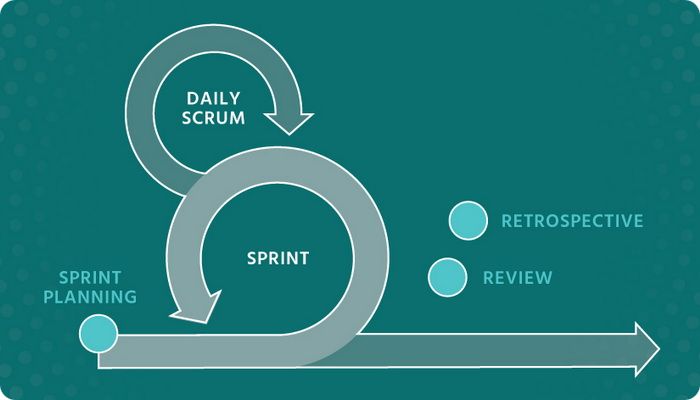Scrum in 5 Minutes: A Simplistic and Humorous Guide

Introduction
Welcome to my guide on Scrum, the Agile framework for managing projects.
In this guide, I’m going to explain Scrum in under 5 minutes in a simplistic way, with a dose of humor and anecdotes from my personal experience.
Whether you’re new to Scrum or just looking for a quick refresher, this guide is for you.
So sit back, relax, and get ready to learn about Scrum in a fun and easy-to-understand way.
What is Scrum?
Scrum is a framework for managing projects, particularly software development projects. It is an Agile methodology, which means it emphasizes flexibility and the ability to adapt to changing requirements.
It’s simple to understand and easy to implement, even for teams that are new to Agile.
The key is to keep things short and sweet. Scrum meetings, for example, should be no longer than 15 minutes.
And the overall goal of the project should be clearly defined and communicated to everyone on the team.
One of my favorite things about Scrum is the daily stand-up meeting.
This is a quick meeting where team members give a brief update on what they did yesterday, what they plan to do today, and if they have any blockers.
This helps keep everyone on the same page and ensures that the project stays on track.
Another key aspect of Scrum is Sprint. This is a set period of time (usually 1-4 weeks) during which the team works to achieve a specific goal (Sprint goal).
At the end of the Sprint, the team reflects on what went well and what needs improvement.
This helps the team continuously improve and deliver value to the customer.
How Scrum helped me…
In terms of personal experience, Scrum has helped me a lot to be more organized and efficient.
I remember I was working on a project where we were using traditional Waterfall methodology. We were struggling to deliver the project on time and the client was not satisfied with the end product. After we switched to Scrum, things changed dramatically. We delivered the project on time, the client was happy and the team was more productive and motivated.
One time, during a Sprint retrospective, our team was discussing what went well and what needed improvement. One team member brought up the fact that they felt the daily stand-up meetings were taking too long.
To add a touch of humor, our Scrum Master decided to bring in a kitchen timer and set it for 5 minutes.
From that day on, we all knew that if the kitchen timer went off during a stand-up meeting, it was time to wrap it up and move on to the next task.
It was a small change but it made a big difference, not only it helped us to keep the meetings short but also made the meetings more fun and less formal.
It also created a friendly competition among the team members to wrap up their updates before the timer goes off.
This small thing shows that Scrum can be fun and lighthearted, even when you’re dealing with serious business.
Introduction to Scrum roles
- The Product Owner is responsible for representing the customer and ensuring that the team is working on the most valuable items. They are the ones who decide what gets added to the product backlog and prioritize the items.I remember once, during a Sprint planning meeting, our Product Owner had brought in a giant cookie jar, and every time an item was added to the product backlog, they would reach in and pull out a cookie as a reward. It may sound silly now, but it helped to make the meeting more fun and lighthearted and also helped everyone to stay focused on the goal.
- The Scrum Master is responsible for facilitating the Scrum process and removing any obstacles that may be preventing the team from working efficiently. They are the ones who make sure that the team is following the Scrum framework.In one of our projects, our Scrum Master was a big fan of Star Wars, so he decided to dress up as Darth Vader for our Sprint retrospective meeting. It was a big surprise for all of us, and it helped to break the ice and make the meeting more fun. It also helped the team to remember that even though we were discussing serious business, it was important to have a sense of humor and not take ourselves too seriously.
- Developers in Scrum are responsible for delivering the product increment. They are the ones who do the actual work of designing, developing, and testing the product.Once during a Sprint review meeting, Developers decided to present the product increment in the form of a musical. They sang and danced their way through the features, and it was a huge hit with the stakeholders. It helped to make the meeting more engaging and memorable and also helped to show the stakeholders that the team was creative and taking ownership of the project.
What is Increment in Scrum?
In Scrum, an increment is the sum of all the product backlog items that have been completed during a Sprint and the value of the increments of all previous Sprints.
In other words, it’s the part of the product that’s been built and is ready to be delivered to the customer.
Imagine you’re building a sandwich. For each Sprint, you add a new ingredient to the sandwich. By the end of the Sprint, you have a delicious, fully-loaded sandwich ready to be devoured by your hungry customer.
And just like a sandwich, every increment is a tasty layer of functionality that adds value to the final product.
Let me share another analogy. Think of the increment as a puzzle, each Sprint you add a new piece to the puzzle, and by the end of the Sprint, you have a complete puzzle that looks great and makes sense.
The increment is the final piece that completes the puzzle and makes it whole.
Introduction to Scrum artifacts
Scrum artifacts are the backbone of the framework and help the team to stay organized and focused on delivering value to the customer.
Scrum has three main artifacts: the Product Backlog, the Sprint Backlog, and the Increment.
- The Product Backlog is a list of all the features, functions, and requirements that need to be built for the product. It’s like a grocery list for the project.
Think of it like a menu at a restaurant. The Product Backlog is the list of all the dishes that need to be cooked and served to the customer. Just like a menu, the Product Backlog should be constantly updated and refined to ensure that the customer is getting the best possible experience. - The Sprint Backlog is a list of items from the Product Backlog that the team plans to complete during the current Sprint. It’s like a shopping list for the team.
Imagine you are going to have a party and you need to buy the ingredients to make the dishes, the Sprint Backlog is like the list of items you need to buy for the party and the team is the one responsible to buy the items. - As I explained before, The increment is the sum of all the product backlog items that have been completed during a Sprint and the value of the increments of all previous Sprints. It’s like the final dish that you serve to the customer.
Let’s sum up
Scrum is a great way to get started with Agile and can help teams deliver better results.
Just remember to keep things simple and focus on delivering value to the customer.
And always, always, keep your stand-up meetings under 5 minutes, otherwise, you’ll start hearing complaints like “My legs are getting tired” or “Can we just sit down next time?”
If you’re looking for a simple and effective way to manage your projects, give Scrum a try.
With its focus on flexibility and adaptability, it’s a great way to get started with Agile.
And with its emphasis on short, sweet meetings and continuous improvement, it’s sure to help you and your team deliver better results.
Don’t be afraid to be creative and have fun with it, just like the kitchen timer story.
So, why not give Scrum a try TODAY and see the difference it can make for your team and your projects?
